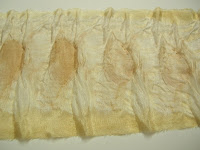
I spent yesterday trying out the plant material using two different methods:
Experiment 1 - making bundles or folds of dry fabrics with plant material enclosed inside, which were fastened with thread or metal clips.
Experiment 2 - boiling plant material in a little water for 1 hour to release the colour, then removing from the heat source and placing damp fabric in the dye/stain.
Below are a few images that demonstrate the initial plant material and some of the resulting fabrics.
Brown onion skins





Bilberries (harvested on Stanton Moor)
Green walnuts (collected from the ground, Chatsworth House)
I am particularly happy with the results of the walnut and bilberry stains. I was fascinated by the results of experiment 1, where the plant material was enclosed in the fabric; the slices of walnut have created wonderfully subtle embossed prints on velvet.










thank you for the kind mention...and that's probably the safest thing to do with those bilberries
ReplyDeleterumour has it that even now over a quarter of a century after the Chernobyl disaster, wild foods such as berries and fungi growing in western Europe
are sufficiently radioactive to adversely affect your health if ingested
now wondering whether those samples glow in the dark, too...
This comment has been removed by the author.
ReplyDeleteHi Hannah, very interesting and I particularly like the Bilberry and Walnut also. I am also looking into more natural dying and have bought some dyes from "Scottish fibres" based in Edinburgh but will also experiment with Blackberries from the garden. I wouldnt have thought of using velvet but thats the beauty of experimenting!! CA
ReplyDeleteI tend to view rumour with a healthy mistrust (intriguing though it is) - so I hope a lifetime of eating wild blackberries won't prove to be fatal. My husband studied contaminated land and groundwater at Masters level, so I will check with him on that.
ReplyDeleteCarolann - I think it is well worth exploring 'found' colours, especially ones you can collect yourself. Have a look at India Flint's website and blog. Think about why you want to use natural dyes, and then consider whether buying prepared products by mail order is really in the spirit of what you want to achieve.Anyhow, no tutorials now, it's summer. Enjoy your holidays!
ReplyDeletethanks Hannah. Think I automatically thought about natural dyeing and bought some - instead of going back to basics. Will look at India's website. Its to do with one of my summer project titles "Shreds of Evidence" and I realise now that I need to do a lot more research into this subject and how to use the found colours.
ReplyDeleteHi Hannah
ReplyDeleteI bought India's book Eco Colour early this year - which is very beautiful and well worth the pennies. You are welcome to borrow it. Love your experiments, seems like you are meking good progress over the summer without us students bothering you!
I love the way you have presented your samples. I have been posting recently about natural dyeing. I have two blogs and I posted my experiments with red dyestuffs on www.love-stitching-red.blogspot and so far greens and yellows on www.carolynsaxby.blogspot.com. I also tried madder and got orange and purple and blueberries where I got very dark purples. I thought you might be interested. Yours are beautiful
ReplyDeleteBest wishes
Carolyn